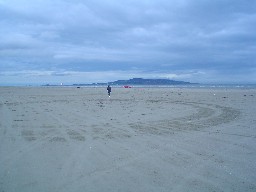 |
The Bull Island The Bull Island has being closed to Motor Cars Also I believe that closure has being closed for unsocial Behaviour! |
|
| The uses of the
Bull Island, mainly recreational, are almost endless. Its proximity to over one
million city dwellers (it is just 8 kilometres/5miles from Dublin city centre) makes its
extensive beach situated on the eastern side of the island, a favourite haunt for
Dubliners. With two access roads and 4.85 kilometres of a strand even the litter
problems being experienced there in recent years cannot diminish Dollymount as a really
attractive beach. While on the beach, especially in Summertime, the activities
engaged in are many and varied. As many as 10,000 people have been on the island on
some fine summer days. This includes those using the facility as a public park, as a beach
and the golfers. One can simply appreciate the scenic seaside area for its own natural beauty and enjoy a day on the beach. One can enjoy a panoramic view of Howth and the Dublin Mountains, the spires, towers and chimneys of the city. Dublin harbour and its shipping and the mainland of Clontarf, Raheny, Sutton and Killbarrack. The water can be used for swimming, bathing, fishing or sailing. The beach itself is ideal for summer sunbathing, for picnics and barbecue parties, for walking, jogging and running. Children can play and build sandcastles. The island is patrolled by wardens and Dublin Corporation is at present preparing a long term plan to provide facilities or special zones for the various activities engaged in on the island. Video copyright Marino Local History Society. The dune complex is a public park with a difference - its natural character is quite distinct from the conforming landscaped environment of the regular urban park. The island is the largest city park under the control of Dublin Corporation Parks Department. Indeed when weather conditions are unfavourable on the Bull Island people tend to make use of Clontarf's more sheltered St. Anne's park. In this way the island and St. Anne's complement each other. The importance of the Bull Island as an educational centre cannot be overstated. It is a natural environment set in the middle of a built up area - it is accessible, large and safe. The whole island can rightly be described as an outdoor, living, ecological laboratory. The island provides habitats of great ecological importance. Its sedimentology and geomorphology can be studied in detail. The beach area supplies ample scope for the study of living organisms being transformed into fossils....even a variety of ripple marks can be examined. The whole island is a major national scientific resource actively in use. It provides an exploration area for botanists, ecologists, marine biologists, insect hunters and natural historians. The very fact of its permanently changing physical form - its continuing growth, changes in soil type and plant cover give scientists an exceptional interest in the island and its processes. Estimates suggest that 8,000 students a year study the development of the Bull Island. As a scientific and educational workshop, then the Bull island is available to everyone to study. Surveys show that its greatest users are post-primary and third level students of Dublin city and county for areas of their Biology, Geography, Geology and Natural History curricula. In fact about 1,000 University students in Dublin each year have their degree courses in biology and earth sciences associated with the island. These range from excursions, to long term research. Teachers in the primary school system also, quite regularly, bring their classes for a day on the beach, or for some practical work on a field trip. Other amateur organised groups such as the Dublin Naturalists Field Club, the Irish Wildbird Conservancy and the Geographical Society of Ireland use the facilities of the Bull Island for various projects. And conservationists and individual wildlife admirers simply like to visit the island, walk around and appreciate all it has to offer. For ordinary, everyday study - Maybe just reading notes, or a book - many students like to find a little corner - 'a haven of tranquillity' - among the sand dunes of the Bull and study in the peaceful atmosphere provided, weather permitting of course! In the same way many writers, artists and poets use the island. They find it the ideal retreat where the permeating peace, the sea breeze and the lapping waves remove them from regular everyday life and bring inspiration to the pen or brush. Many nature lovers like to simply retreat to the solitude the island provides. An extract from the book The Meadow of the
Bull a history of Clontarf by Dennis McIntyre |
